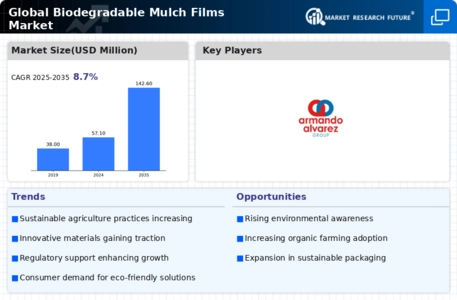Market Trends
Key Emerging Trends in the Biodegradable Mulch Films Market
The global biodegradable film market is rapidly exploring the latest trends including a rising awareness of environmental concerns, and increasingly the ecofriendly practices are being adopted. An environmentally conscious alternative to the traditional plastic films, used to cover soil in agriculture, called the biodegradable mulch films is currently has been found more effective due to its natural decomposition.
One worth emphasizing is the market trend of leaders asking for eco-friendly agriculture inputs. As part of a growing response to the problem that traditional plastic films generate by causing land degradation, and as the awareness increases that soil health and ecological conservation have to be promoted, growers and resource users are looking for novel approaches to reduce plastic waste and support expansion of soil habitat. With biodgrades as a broad category encapsulating various substances, including starch, polylactic acid (PLA), and polyhydroxyalkanoates (PHA), we have identified viable alternatives to address these challenges.
Apart from supply and demand, the government has also onethough the actions and regulating measures that are aimed at the promotion of the sustainability of the agricultural practices have also contributed to this trend. In this matter, many countries are moving towards that regulations that support the usage of biodegradable mulch film were toche lessen the environmental problem that agriculture brings about. Such rules typical are the ones that provide the farmers with the incentives to take their green practicem, and so actually supports the market growth.
Among the other elements responsible for market strive, of course, represents the advancements in research and development of biodegradable materials. Over time, research manufacturers will look towards utilizing new innovative materials and formulations to improve the quality and longevity of biodegradable mulching materials. As such, the herbs used in these films do not only naturally biodegrade and offer excellent weed control, but also keep the soil warm, retaining moisture similar to a traditional plastic mulch film.
The market has been manifested with a steep rise on agricultural groups dealings and partnerships as well as amplified biodegradable mulch film manufacturers' collaborations with research institutions. These interactions tend to bring together skills in agriculture, materials science and technology so as to generate composite solutions that address shifts in the agriculture market demand. This cooperation has made a step change in the rapid growth of the market for biodegradable mulching films globally.
It is cost-effectiveness that also prove as the determinant of the market's trends. Although biodegradable mulch film would be more expensive than conventional polyethylene film, its long-term potential to reduce environmental footprint and improve soils health, rated as one of the investments for environmentally proactive farmers. With production ability seeing such improving areas and production processes becoming more efficient, competition should bring the prices down, or rather, ensure that the biodegradable covers will be affordable to not only the big stakeholders in the agriculture arena.

















Leave a Comment